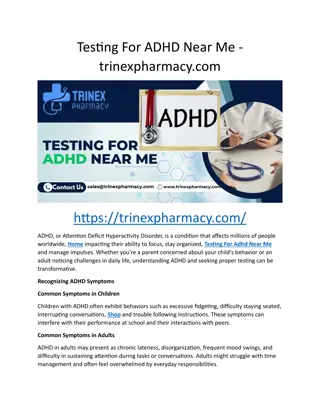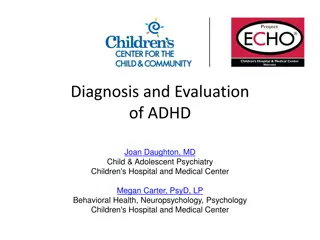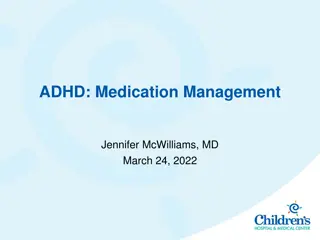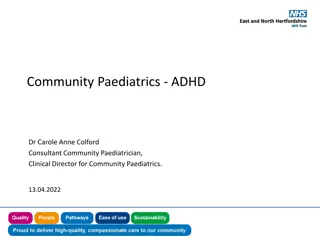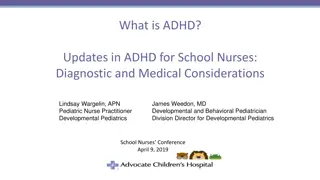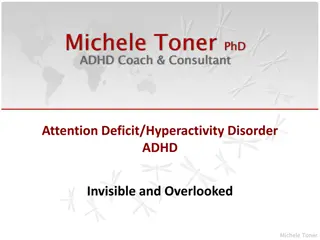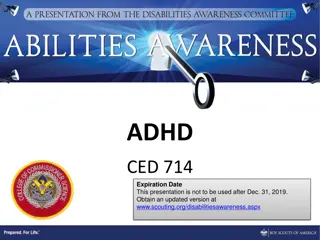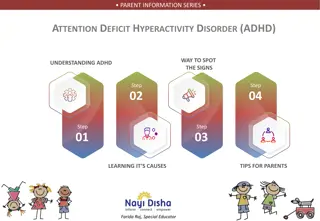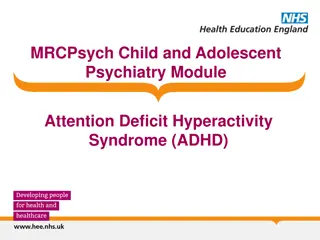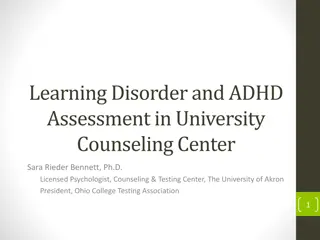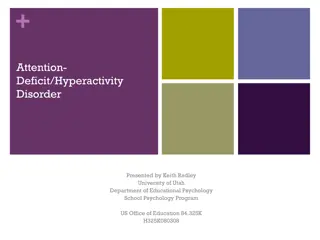Effect of Spaced Training in ADHD: Study on SHR Population
Spaced training in the 5CSRTT proves beneficial for Spontaneously Hypertensive Rats (SHRs) in early levels, showing potential improvement in attention and performance abilities. The study explores the impact of spacing training sessions and highlights a significant improvement, especially in males during earlier training levels. Research on spacing in ADHD is limited, making this study crucial for understanding how spacing can enhance focus and reduce symptoms in individuals with ADHD.
Download Presentation

Please find below an Image/Link to download the presentation.
The content on the website is provided AS IS for your information and personal use only. It may not be sold, licensed, or shared on other websites without obtaining consent from the author. Download presentation by click this link. If you encounter any issues during the download, it is possible that the publisher has removed the file from their server.
E N D
Presentation Transcript
Spaced Training in the 5CSRTT Proves Beneficial in Early Levels For SHRs Rebecca Warren
ADHD is a neurodevelopmental disorder that typically leads to lower academic performance. Spaced training involves studying over short periods for multiple days rather than multiple hours in one day, or massed training. Yet no study has performed spacing in an ADHD population. Using a rat model of ADHD, known as the SHR strain, the present study assessed how spacing training from 90-trials a day to 45-trials a day in the 5CSRTT would improve performance abilities. It was found that spacing was beneficial during earlier levels of 5CSRTT training, that required less focused attention. In addition, during the earliest level of training, males in the spaced condition benefited more than females, closing the previously reported sex gap. These findings imply that by spacing training, the SHRs demonstrate a significant improvement in some training levels of the 5CSRTT. Future studies should assess spacing academic work and attentiveness training in children with ADHD. Abstract
Research on spacing in ADHD is very limited Why this topic? Improving children s focus and limiting debilitating symptoms should be focused on from many angles. Not simply giving medication The 5CSRTT measures ADHD-like symptoms well and the SHR is a very good correlate to children with ADHD
Introduction: What is ADHD Attention Deficit Hyperactivity Disorder (ADHD) is a neurodevelopmental disorder characterized by inattention, impulsivity, and hyperactivity ADHD often leads to lower performance in academic settings Children with ADHD have altered brain function in areas like the frontal lobe that make it more difficult to focus Teaching studies have revealed that children with ADHD benefit from breaks in school Attentiveness training via cognitive video games have proved useful in limiting symptoms for children with ADHD The Spontaneously Hypertensive Rat (SHR) has proved to be a good comparison to children with ADHD
Introduction: What is Spaced Training Massed training involves training continuously without significant rest while spaced training involves rest between training intervals For example, studying for multiple hours in one day is massed training and studying for one hour a day for multiple days is spaced training Spacing has been proven to improve academic performance and memory in both neurotypical and non-neurotypical populations Spacing out attention on tasks has been little studied There has been little research on spacing in either SHRs or children with ADHD.
Introduction: What is the 5CSRTT The 5-Choice Serial Reaction Time Task is an attentiveness task given to rats The rats are shown 5 slots and are taught that when they poke their nose in a slot where the lightbulb is on, they receive a reward As levels increase, the lightbulb, and therefore the time to respond, stays on for a shorter period Therefore, the levels become more difficult as they increase because more attention is required
Introduction: Hypotheses The present study aimed to discover if spacing attentiveness training affected ADHD symptoms including inattention, impulsivity, and hyperactivity. An overall improvement in performance on the 5CSRTT and an overall decrease in hyperactivity was expected to be seen in both groups due to the positive benefits cognitive training can lead to in humans with ADHD This decrease in inattention, impulsivity, and hyperactivity was hypothesized to be more significant in the spaced condition because of spacing s well-known effect on memory and attention in both rodents and humans Moreover, males in the spaced condition were expected to experience a larger improvement in their 5CSRTT attention scores than females in the spaced condition.
Methods: 5CSRTT . This table was adapted from Asinof & Paine's (2014) paper on the 5-Choice Serial Reaction Time Task and was modified to include spaced training. The stimulus duration (SD) indicates how long the lightbulb was on in seconds. The ITI or the intertrial interval was the amount of time between each trial. Limited hold (LH) was the amount of time the SHR had to respond. Time out (TO) was the amount of time the SHR had to wait after giving an incorrect response. SD, ITI, LH, and TO were all recorded in seconds.
Methods Premature responses and percent correct responses were recorded Open field data was also collected to measure for hyperactivity in the SHR This was recorded after each training session was completed in the 5CSRTT This figure is directly taken from the Asinof & Paine (2014) paper
RESULTS: SEX DIFFERENCES IN TR1
Results: Spaced Training Beneficial TR1 & TR3 For both TR1 and TR3, the spaced group made significantly more percent correct responses During TR3, the spaced group made significantly less premature responses The spaced group and massed group both improved significantly over days of training, but the spaced group improved significantly more The effects seen in theses training levels were not seen in TR4 or TR5
Results: Carry-Over Effects When comparing day four of TR1 to day one of TR3, the spaced group showed a significant increase in their percent correct scores and a significant decrease in their premature responses while the massed group did not. Spaced group remembered more from training during TR1 than massed group When comparing day four of TR3 to day one of TR4, the spaced group showed almost a significant decrease in their percent correct scores while the massed group did not. Shows how difficult the transition into TR4 was and how the massed group may have depicted TR3 and TR4 as being equally difficult When comparing day four of TR4 to day one of TR5, both groups showed a significant decrease in their percent correct scores For premature responses on day four of TR3 and day one of TR4, there was no significant difference in the spaced group because they had already decreased by a lot and the massed group was catching up
Results: No Decrease in Activity in Open Field SHRs remained hyperactive in the open field despite training Females were more active than males in the open field
Spacing was beneficial during 5CSRTT learning. Giving the spaced group fewer trials to focus on in each session increased their ability to pay attention and therefore improved their overall score. ADHD is a disorder that pervades many children s academic lives because of their difficulties with maintaining focus. If spacing is instituted in school settings, an increase in academic performance for children with ADHD could be observed. Discussion: Wrapping It Up Furthermore, if spacing is given during attentiveness training, training that has been proven to reduce ADHD symptoms, there is a high possibility the training could be more effective Helping children with ADHD does not have to preferentially involve giving medication, it can also circulate around changing systems or practices that currently do not benefit those with ADHD. Future studies should consider spacing out the harder training levels for longer to see if performance could improve Future studies may also consider spacing trials for shorter intervals to see if performance is effected
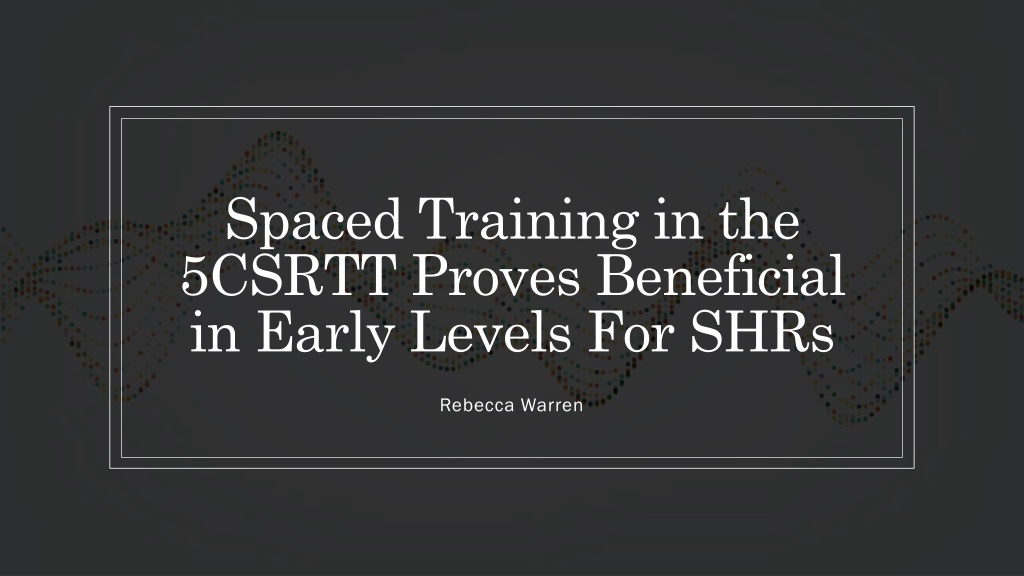
 undefined
undefined


















